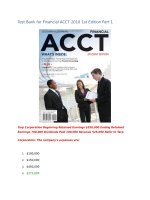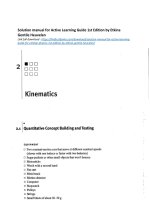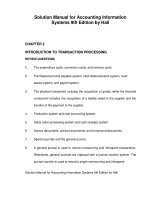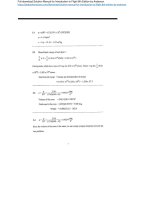Solution manual for managerial ACCT 2010 1st edition by sawyers
Bạn đang xem bản rút gọn của tài liệu. Xem và tải ngay bản đầy đủ của tài liệu tại đây (57.55 KB, 5 trang )
buy this full document at
Chapter 1
Introduction to Managerial Accounting
Concept Questions*
1.
(LO 1—Data, information, and knowledge)
Data include items such as sales invoices, purchase orders, customer lists, and
inventory records. Data are facts and figures that have not been organized and
transformed into information. Information is data that has been sorted, organized,
processed, and summarized. Knowledge is information that is shared and
exploited so that it adds value to an organization.
2.
(LO 2—Managerial versus financial accounting)
The primary purpose of financial accounting is the preparation of general use
financial statements for use by creditors, investors, and other users outside the
company. The primary purpose of managerial accounting is the generation of
financial and nonfinancial information for use by managers in their decision
making roles within a company.
3.
(LO 2—Strategic and operational planning)
Operational planning involves the development of short-term objectives and
goals. Strategic planning involves the development of long-range goals and
objectives.
4.
(LO 2—Role of finance function)
The finance function is responsible for managing the financial resources of the
organization. Finance managers make decisions about how to raise capital as
well as where and how it is invested.
5.
(LO 3—Role of the managerial accountant)
Advances in accounting information systems and other changes in the past five
or ten years have resulted in the automation of traditional accounting functions
involving data collection, data entry, and data reporting and a corresponding
shifting of those functions from managerial accountants to clerical staff.
Consequently, many managerial accountants now focus on analyzing information
and creating knowledge from that information rather than collecting data.
6.
(LO 3—Sunk and opportunity costs)
Sunk costs are costs that have already been incurred. As a result, they cannot be
avoided and are not relevant in decisions. Opportunity costs are benefits forgone
by choosing one alternative over another and are relevant costs for decision
making purposes.
*Concept Questions are found on the student review cards.
buy this full document at
Solutions Manual
7.
(LO 4—Ethics)
As there is no one correct answer to this question, student responses will vary.
You may wish to utilize this quote to initiate a group discussion about whether
corporations have social responsibilities.
Exercises
1.
(LO 2—Users of accounting information)
Note to Instructors: Student responses will vary to this question. You may find
that students will have difficulty identifying the types of information needed by
these individuals and organizations because they lack experience with
accounting. You may find that this question is useful as an in-class discussion
exercise. Below are a few of the potential answers that students may provide.
a. Financial statements, cash flow projections, sales projections, and budgets.
b. Sales projections, financial statements, payroll analysis and related data,
production budget, productivity data, and employment contracts for
management.
c. Production budget, labor budget, purchases budget, sales projection, and
variance analysis (i.e., actual versus budgeted performance).
d. Financial statements, management discussion and analysis, and filings made
with the Securities and Exchange Commission by public companies.
e. Production budget, sales projection, product cost reports, inventory reports,
and shipping schedules.
f. Financial statements, budgets, projections and analyses (e.g., sales, cash
flow, market share, and inventory), variance analysis, and filings made with
the Securities and Exchange Commission by public companies.
2.
(LO 2—Managerial vs. financial accounting)
Managerial accounting
Timeliness is critical
Information is often less precise
Future orientation
Reports results by segments
Highly customizable
3.
Financial accounting
Must follow GAAP
Focused on past performance
Emphasizes reporting on the
whole company
Information is often “old”
(LO 2—Types of business managers)
1-2
© 2011 Cengage Learning. All Rights Reserved. May not be scanned, copied or duplicated, or posted to a publicly accessible
website, in whole or in part.
Full file at />
a.
b.
c.
d.
4.
finance managers
marketing managers
human resource managers
operations/production managers
(LO 4—Decision making and ethics)
Note to Instructors: This question is loosely based on the facts surrounding the
Ford Explorer/Firestone tire rollover problems in 2000. As part of the discussion,
you may want to discuss the role of risk in analyzing and making decisions.
A.
Regardless of fault, Henry Powell, Inc., should immediately advise
suppliers and consumers of the potential danger and try to either fix the
problem or design a safeguard for the mower to protect users.
B.
Ideally, Henry Powell, Inc. should work hand in hand with the lawn mower
manufacturer in order to pinpoint the problem and develop a solution.
C.
Stakeholders impacted include the customers who bought the mowers
with the battery and the manufacturers of this mower. Both Henry Powell,
Inc., and the lawn mower manufacturer have an ethical responsibility.
Henry Powell should alert the lawn mower manufacturer in an attempt to
pinpoint the cause of the problem. Both companies should contact
potential consumers and immediately offer to replace the batteries.
Problems
5.
(LO 2—Financial vs. managerial accounting)
A. Financial accounting is concerned with the preparation of general purpose
financial statements used by external parties, while managerial accounting is
concerned with generating financial and nonfinancial information used by
internal parties.
B. Each type of accounting exists to provide appropriate information to the
relevant users. Not all individuals or organizations have the same information
needs.
C. Financial accounting information is primarily used by stockholders, creditors,
and other external parties. Managerial accounting information is primarily
used by managers and company employees.
6. (LO 3—Decision making and relevant factors)
1-3
© 2011 Cengage Learning. All Rights Reserved. May not be scanned, copied or duplicated, or posted to a publicly accessible
website, in whole or in part.
Solutions Manual
A.
B.
7.
The problem faced is basically one of choosing the “best” flight. However,
“best” depends on a variety of individual factors, often qualitative, that will
differ among students.
Although answers will vary, quantitative objectives might include
purchasing the least expensive flight or purchasing a flight for less than
$750. Qualitative objectives might include making sure that you arrive on
time, or other factors like having the greatest amount of leg room and inflight amenities.
C.
Not all of the factors are relevant in choosing among flights. For example,
since the cost of beverages is the same for flights 1, 2, and 3, it is not
relevant in deciding among those flights. Likewise, the cost of a first-class
upgrade is the same for flights 2 and 3 and would not be relevant in
comparing those flights. The costs of the other options are relevant since
they differ between alternatives. Qualitative factors include variables such
as leg room, the probability of an on-time arrival, and access to in-flight
amenities and food.
D.
The best choice will depend on the specific objectives identified by
students. While flight 1 is certainly the cheapest, the number of
connections and flight time are likely to increase the chances of a late
arrival. If on-time arrival is a key objective, students might prefer flight 2 or
flight 3.
(LO 3 and 4—Decision making and ethics)
A.
Ken may identify the objectives of the dangers associated with the
defective engine, including people getting hurt or killed and the legal risks
and damage to the company reputation that such an accident would
cause. The high cost of handling the problem, including a potential recall,
is also an objective.
B.
Ken could notify his superiors of the problem with the seal and
recommend that the company take immediate corrective action.
Alternatively, Ken could choose to ignore the problem, noting that the seal
is unlikely to leak, which would avoid costly remedial action.
C.
Knowing that the part may fail certainly requires the company to take
some remedial action. At the very least, the company should inform the
airplane manufacturers and the airlines that the problem exists. The
company would then be in a position to work with these affected parties to
share the cost of repairing or replacing the defective parts with
nondefective ones.
1-4
© 2011 Cengage Learning. All Rights Reserved. May not be scanned, copied or duplicated, or posted to a publicly accessible
website, in whole or in part.
Full file at />
D.
While cost is a consideration in most business decisions, the cost is not
likely to be highly significant. The costs of a catastrophic event would be
much greater to the company.
1-5
© 2011 Cengage Learning. All Rights Reserved. May not be scanned, copied or duplicated, or posted to a publicly accessible
website, in whole or in part.









